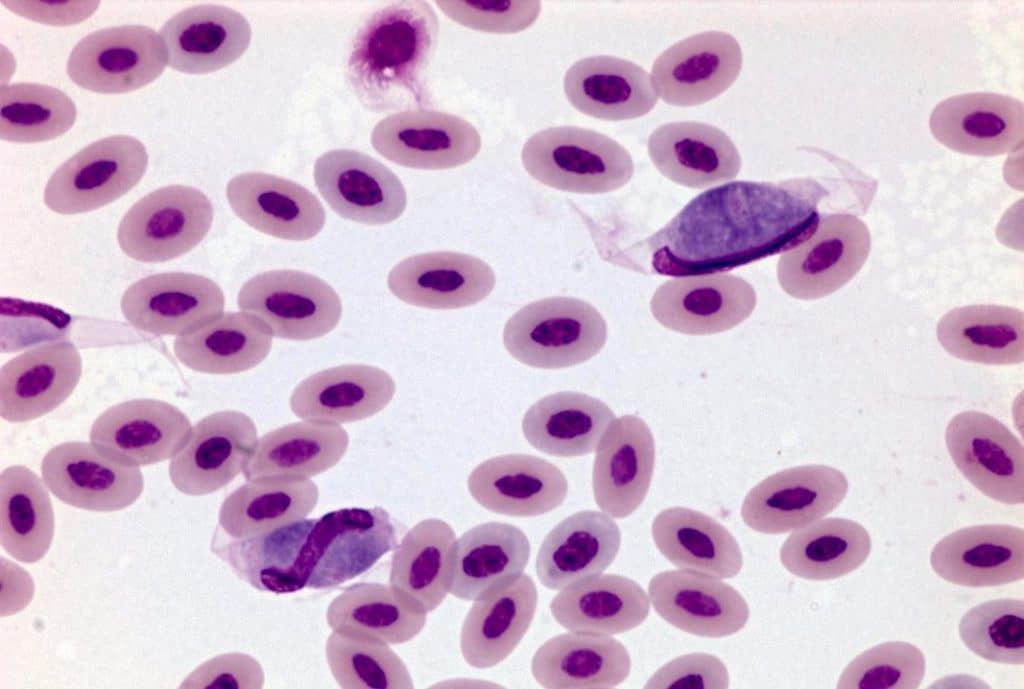Blood parasitic disease in chickens is a dangerous disease that reduces the growth and reproduction of chickens. Although the level of infection is low, the death rate is high because chickens are immunocompromised.
The chickens show signs such as: fatigue, sluggishness, loss of appetite or decreased appetite, pale combs with increasing frequency, fever, decreased laying, diarrhea with dark green stools, or even blood that does not clot or Hemophilia or not?
If your chickens are showing one or more of the above signs, it is likely that they are infected with a disease that we often call blood parasitic disease in chickens.
So is blood parasites in chickens dangerous? Does it cause much damage?

Image of blood parasite disease in chickens
I. WHAT IS BLOOD PARASITE DISEASE IN CHICKENS?
– Blood parasitic disease in chickens is caused by a type of protozoan parasite in the blood called Leucocytozoon. There are intermediate vectors such as midges, discs, etc. When biting and transmitting the disease into the chicken’s body, protozoa develop and parasitize the chicken’s red blood cells.

Image of blood parasite disease in chickens
– Vietnam’s hot and humid tropical climate is extremely favorable for intermediate hosts to grow and cause disease, especially during the humid rainy season. That’s why most chicken farmers in our country have to decide to “live with” blood parasites in chickens because it is very difficult to destroy or control the intermediate hosts.
– When chickens get sick, the damage is not only the immediate things that can be seen and measured such as infection rate, death rate, etc. but it is mainly the consequences that follow later such as decreased weight gain, reduced fertility, anemia, immunodeficiency and multiple infections with other dangerous diseases increase the death rate.
– According to statistics, blood parasites in laying hens cause the laying rate to decrease on average from 75% to 25% after infection and it takes about 2 months to recover to the normal egg laying rate.
II. SYMPTOMS
- The chicken has a high fever, moves less, tired, the chicken is moody and stops eating, the color of the chicken’s comb is pale, becoming white after many days. Chickens often lose balance, breathe rapidly and have anemia. Chickens have diarrhea and green feces. If the disease is severe, the chicken will have bloody stools due to damaged intestines. Special attention should be paid when the number of chickens showing symptoms gradually increases in the flock.
- In laying hens: in addition to the typical symptoms mentioned above, there is also a decrease in egg production and unusually small eggs, with many eggs with soft shells that easily break or very thick shells, when the eggs meet the chicken flock’s standards. Diseases in incubation sharply reduce the embryo rate and hatching rate, and many chicks die in the first 3-5 days.

Image of blood parasite disease in chickens
III. TREATMENT
a, Prevent contact between intermediate hosts and chickens:
– Clear the entire farm space, do not allow insects to have a place to live, spray disinfectant to disinfect the livestock environment.
– Use insecticides and mosquito sprays in and around the camp.
– Replace with new bedding that has been sprayed with disinfectant
b, Add supporting products
– Liver and kidney tonic (Carnitonic oral, Phosretic)
– Increase strength and prevent bleeding with G-CKC, G-AKC
– Reduce fever with the herbal product FEVER FORT and your chickens will get better quickly and eat again quickly
c, Special medicine
– INTERTRIM 480 ORAL from Interchemie Netherlands or SULMOTRI 480 ORAL from VB Pharma or SULMOTRI WS from VB Pharma
Although blood parasitic diseases in chickens spread slowly, they have a high mortality rate if not promptly detected and treated. The above information will help farmers take care of chicken flocks more effectively.
